

|
Problems 1 to 7, and 10 Cristina Aurrecoechea Fall 2005 |
I liked this introduction to Centers of Triangles. This table summarizes the classic four centers:
|
|
|
|
|
|
|
|
|
Orthic triangle. |
|
|
|
|
Medial triangle. |
|
|
|
|
Circumcircle (r= from center to any vertex). This circle "contains" the triangle. |
|
|
|
|
Incircle (r= from center to intersection of a side and its perpendicular passing through I). The triangle "contains" this circle. |
The orthocenter is the concurrent point of the altitudes, as shown in Figure 1. This gsp file provides the tool to construct the orthocenter H. Use it to check the location of H as the shape of the triangle varies.

Th orthic triangle connects the three altitude feet. It stays inside the original triangle while H stays inside, that is, as long as the original triangle is not obtuse. Figure 2 shows the orthic triangle for an acute, right and obtuse triangle.

Check this file to explore the shape and location of the orthic triangle as the original triangle changes its shape. It is interesting to observe that its Incenter is the orthocenter of the original triangle, that is, the altitudes of the original triangle are the angle bisectors in the orthic triangle. Open tools.gsp to have access to the tools we provide and construct the orthocenter of the original triangle and the incenter of its orthic triangle.
The centroid is also known as the center of gravity G. Each median divides each side into two equal segments, and the the triangle into two triangles of equal area. This gsp file provides the tool to construct the centroid G. Use it to check the location of G as the shape of the triangle varies.
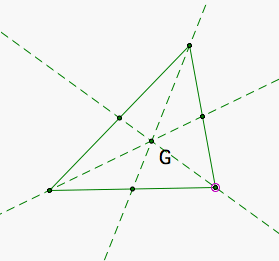
The medial triangle connects the sides midpoints of the original triangle. Figure 3 shows the medial triangle for an acute, right and obtuse triangle.

The medial triangle divides the original triangle into four congruent triangles. This file allows you to explore the centers of these four triangles.
An interesting observation is that the orthic triangle is the one with minimal perimeter of all possible inscribed triangles (as long as the original triangle is acute).
The circumcenter (C) is the concurrent point of the perpendicular lines at side midpoints, as shown in Figure 4. C is the center of the circumcircle: unique circle that passes through the vertices. This gsp file provides the tool to construct the circumcenter C and the circumcircle. Use it to check the location of C as the shape of the triangle varies.
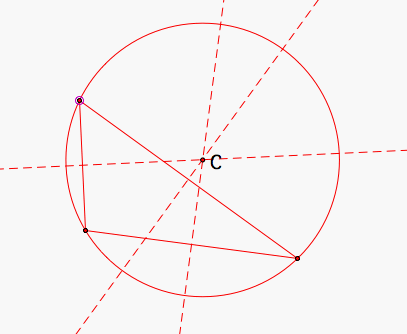
The incenter (I) is the concurrent point of the angle bisectors, as shown in Figure 5. I is the center of the incircle: unique circle that is tangent to all three sides of the triangle. This gsp file provides the tool to construct the incenter and incircle. Use it to check the location of I as the shape of the triangle varies.

The Euler line is a segment that connects the three centers: H, G and C of a triangle. Figure 6 shows how the location and orientation of the euler line varies with the triangle shape. Figure 6 also shows the intersections in each side of the corresponding concurrent lines (altitude feet, midpoints and angle bisector intersections). In a right triangle the euler line divides the triangle into two isosceles triangles. In an obtuse triangle two of the three altitude feet lie outside the triangle, on the lines extending the sides of the triangle. Figure 6 shows in blue the two altitude feet outside the triangle. Observe that if the euler line is 1 unit long, the centroid G is located 1/3 units from C and 2/3 units from H. Proof this assertion.

This file lets you observe the euler line, its location, size and orientation.
It is interesting to explore the locus of the centers of a triangle as one vertex moves along a line parallel to the opposite side (generating triangles of same area). Figure 7 shows the parabola traced by H, the vertical line traced by C and the horizontal line traced by G. The incenter also traces a curve. This file allows you to investigate this.
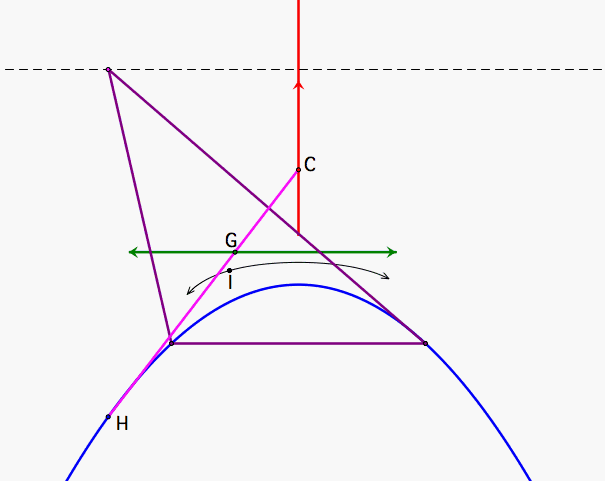
The interesting aspect of this is to prove that the locus of H is a parabola. If it is, the line traced by C is definitely its axis. Could be G's trace its directrix? It is easy to see is that the line traced by G is not its directrix. Here we have some gsp files where we provide the parabola traced by H, constructed with given focus and directrix.
We looked at the traces of the three centers as the vertex moves along a circle instead of a straight line. It is interesting to see that C stays in a vertical line, while G moves follwing the moving vertex (a circle). H and I follow some curves. I's looks like an ellipse. H's is the result of composing a parabola with a circle. Figure 8 is a snapshot from this gsp file.

The 9-point circle is a special circle that connects: the three midpoints, the three altitude feet and the three midpoints of the segments VH, that connect a vertex V with the orthocenter H. Its center is usually called N. Figure 9 shows how its location varies as the shape of the triangle varies. This two gsp files construct the 9-point circle of a triangle, one gives you the circle and its center, the other gives you the circle and the 9 points.

From its definition it follows that the nine-point circle is the circumcenter of the orthic and medial triangles. Another interesting observation is that N lies on the euler line in the midpoint at equal distance from C and H.
This triangle is similar to the original triangle (same angles and proportional sides) and congruent to the medial triangle (equal size sides and angles).

Check this file to explore the shape and location of this triangle as the original triangle changes its shape. It differs from the previous triangles (medial and orthic) in that this one "escapes" from the triangle as this become obtuse (the orthic triangle had always one vertex on the original triangle).
These three triangles have in common that the 9-point circle is their circumcircle, since as we saw before, their vertices are in the 9-point circle.
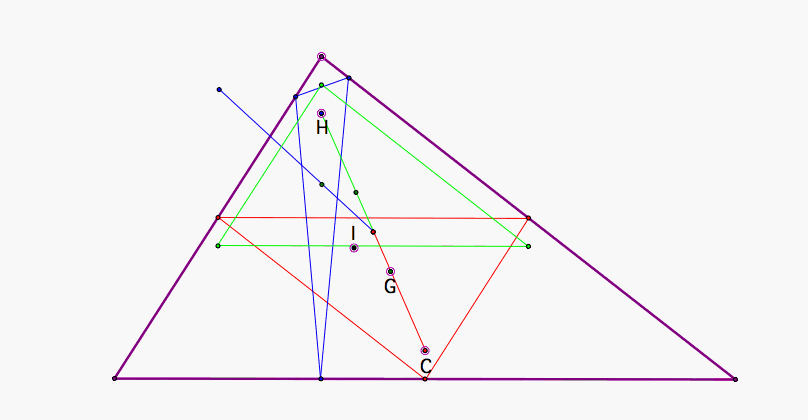
This file lets you explore these triangles together with their euler lines. The three triangles share the circumcenter as explained above. If you show (in the file) the euler line of the original triangle, you will see that: (1) its orthocenter coincides with the orthocenter of the orthic triangle, (2) its centroid coincides with the centroid of the medial triangle, and (3) its circumenter coincides with the orthocenter of the medial triangle.
It would be interesting to look at the locuses of their orthocenters (different parabolas). or any of their centers. Fo example: Figure 10 shows the traces of the centroids. The VH-midpoint triangle's centroid's is a parabola. The one corresponding to the orthic triangle is not a conic.
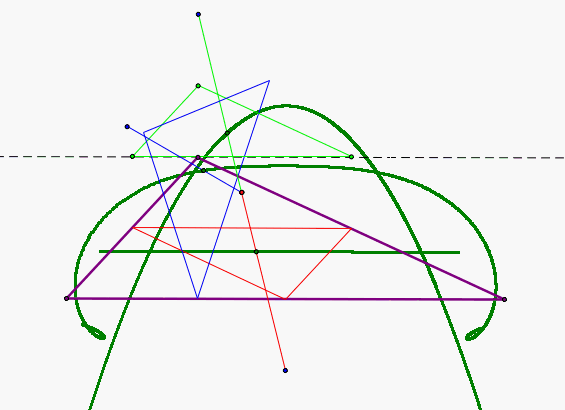
A triangle has three tangent circles located external to its sides. This gsp file provides the construction of one ex-circle. Based on it, this gsp file offers a tool to construct all four circles tangent to a triangle.

There is a relationship between the 9-point circle and all tangent circles (in- and ex-circles) of the triangle: the 9-point circle is tangent to all four of them. Figure 12 shows these circles obtained in the previous gsp file, as an add-on to the ex-circle construction.

Return to Cristina's page with all the assignments.